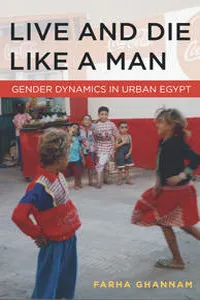New Book From Anthropologist Farha Ghannam Explores Gender Dynamics in Egypt

The recent social and political changes in Egypt have prompted new interest in gender distinctions in the country. In a new book Live and Die Like a Man: Gender Dynamics in Urban Egypt Associate Professor of Anthropology Farha Ghannam shifts the attention from women, the usual focus of media and most scholarly work, to the men of Egypt and how masculinity is actualized and reproduced in daily life.
For her book, Ghannam draws on 20 years of anthropological research in a low-income neighborhood in northern Cairo, not far from Tahrir Square, the focal point for the 2011 revolution. Like many other scholars, Ghannam was originally interested in the study of the female body but over time recognized the importance of studying men, their embodiment, and gendered identities.
"When people think of gender issues in the Middle East, they usually think of women," says Ghannam, whose book was profiled by The Daily Beast earlier in the year. "The stereotype that comes out of the region is that women are oppressed and men are the oppressors. If you look at structures like class and how it intersects with gender, you would find many men in Egypt who are also economically, politically, and socially oppressed."
Ghannam also cites an attempt to humanize Egyptian and Middle Eastern men as part of the reason for her research.
"The idea from the media is that we know all we need to know about men in the Middle East - they are brutal, terrorists, and violent predators who oppress others, especially women and children. There has been no real investment in looking at the daily life of men, their struggles, dreams, and aspirations. As a feminist, anthropologist, and Middle Eastern woman, I am deeply interested in gender inequalities and sought to understand and humanize the huge population we often lump under the Arab/Muslim/Middle Eastern man." Along with humanizing men in popular discourse, Ghannam hopes that this book will generate new ways of thinking about patriarchy and addressing gender inequalities in the Middle East.
While Ghannam focuses on how individual men come to embody masculine identities, her analysis shows that masculinity is a collective project that is negotiated through interactions between men and women, young and old, and neighbors and strangers. In the book, Ghannam offers rich description of men through various stages of their lives, examining their hopes and aspirations as well as their attempts to become model citizens of Egyptian society. The opening chapter deals with a young boy and his families' attempts to make him into a proper man. Other chapters deal with a 40-year-old man's attempt to find a wife, the role women helping their male relatives become "real men," the daily use and regulation of violence, and the intersection of class and gender in shaping the health and death of men.
Ghannam's research on men was largely done before the Egyptian revolution, but her work speaks to important issues that the protests have brought to the foreground. For example, her study of violence and how it was socially viewed and regulated allowed her to understand how the use of force was kept under control during the Egyptian revolution and how its occasional deployment was viewed by ordinary Egyptians.
"A man's standing in society could be boosted by using violence in the right context, or totally undermined if he uses it the wrong way," emphasizes Ghannam. For example, the use of force "in the proper context, such as when you are defending your family, a female stranger, or someone who is weak," is usually accepted and viewed as part of the conduct of a decent and reliable man. However, if used frequently or to bully others, violence is negatively viewed. She notes the public's perception of former president Hosni Mubarak changed drastically when it was discovered that his supporters used hired thugs (known as baltagyyia) to attack protesters in Tahrir Square in Feb. 2011.
In Ghannam's view, a "real man" in Egyptian society is a complex ideal that encompasses a lot of different norms and values.
"He should be assertive, but gentle. Tough, but kind-hearted. Brave, but caring. These qualities might seem contradictory but they are context bound." Most recently, her knowledge of these social views helped her understand the feelings of her interlocutors in the summer of 2013 when they expressed negative feelings towards ex-president Muhammad Morsi and strongly supported General Abdel Fattah el-Sisi, Commandor- in-Chief of the Egyptian army. While Morsi often was seen as kindhearted (tayyib), most people came to see him as lacking the strength, assertiveness, and skills needed to rule the whole nation and establish security in Cairo and the rest of the country. In contrast, Sisi was seen as assertive, firm, and strong but at the same time as caring, compassionate, and trustworthy. Many saw him as holding the promise of effectively addressing their daily hardships, especially the serious problems of food, transportation, fuel, cleanliness, and security. In particular, they saw him as capable of protecting the country and re-establishing security in Cairo.
Ghannam is working on several papers and a main research project. One of the papers is focused on the gender of martyrdom in Egypt and another is focused on different modalities of fatherhood in Egypt. Her next research project is a comparative study of food, the senses, and urban life. She plans to explore culinary traditions in Egypt and Jordan and aims to explore food as a cultural and social marker that signals collective identities, reflects and reconstitutes class inequalities, reproduces gender distinctions, and reflects religious piety and devotion.



